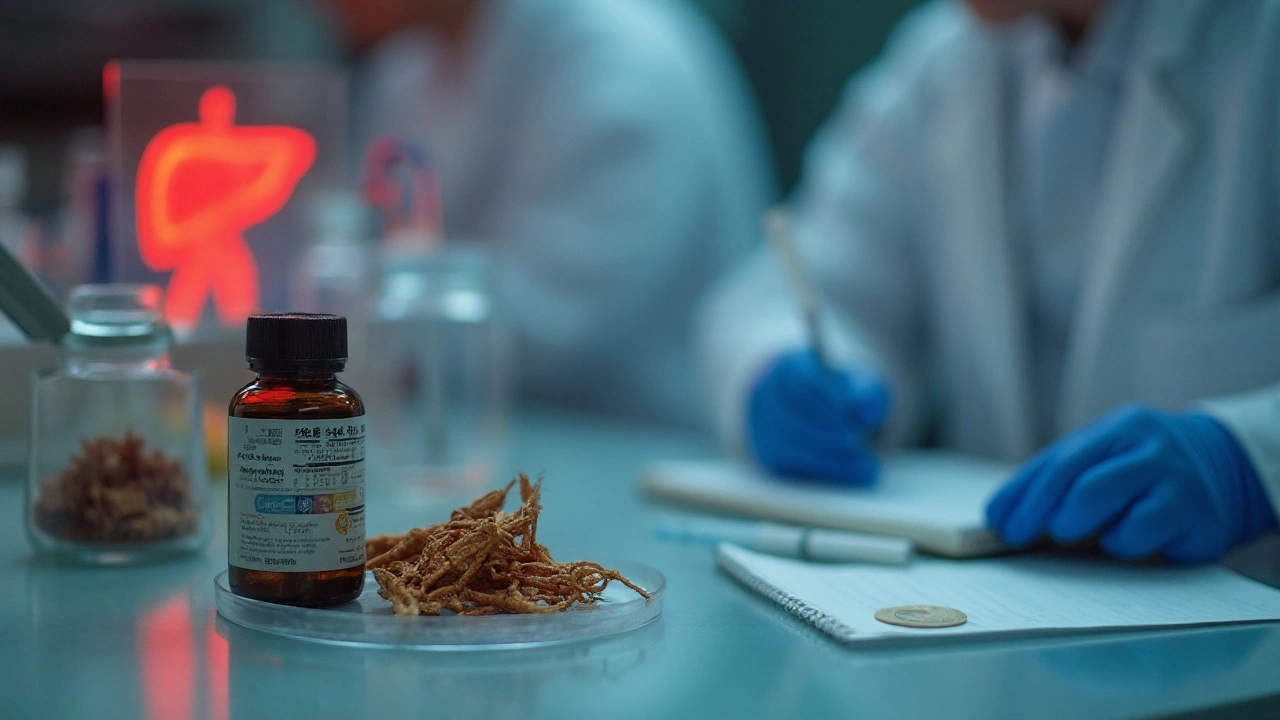Fo‑Ti has a legendary rep for turning back grey hair and boosting vitality. The science? Interesting, but not the miracle TikTok makes it out to be. If you’re curious, you can explore it sensibly. This guide shows what’s real, what’s hype, and how to protect your liver while you test whether it helps you.
TL;DR: The science in plain English
- What it is: Fo‑Ti (He Shou Wu, Polygonum multiflorum/ Fallopia multiflora) is a traditional Chinese root used as a tonic. “Prepared” Fo‑Ti is cooked with black beans; “raw” is unprocessed and harsher on the gut.
- What we know: Lab and animal studies show antioxidant, anti‑inflammatory, and neuroprotective actions, driven by compounds like TSG (a resveratrol‑like stilbene) and emodin (an anthraquinone). Human trials are sparse and small.
- Claims vs reality: Hair and longevity claims are mostly traditional. Some lab signals for hair pigmentation and scalp biology exist, but clinical proof is thin. Energy and mood claims are anecdotal.
- Big risk: Rare but serious liver injury (hepatitis) has been documented in case reports and pharmacovigilance systems worldwide. Risk is higher with raw Fo‑Ti, high doses, and long use.
- Safe use basics: Choose prepared root extracts from reputable brands, start low, limit duration, and check liver enzymes (LFTs) at baseline and 4-6 weeks. Stop immediately if you feel unwell or notice jaundice.
- Australia note: Here, complementary medicines are regulated by the TGA. Look for an AUST L/AUST R number on the label. The TGA has issued safety advisories about He Shou Wu-related liver injury.
What Fo‑Ti actually does: compounds, mechanisms, and what the studies say
Fo‑Ti is not one molecule; it’s a cocktail. The headline compounds are TSG (2,3,5,4’‑tetrahydroxystilbene‑2‑O‑β‑D‑glucoside), emodin and related anthraquinones, plus phospholipids and phenolics. Processing (steaming with black beans) reduces certain laxative anthraquinones and changes the profile, which is why traditional medicine distinguishes “raw” (sheng) from “prepared” (zhi) forms.
Mechanistically, TSG behaves a bit like resveratrol. In cell and animal models, it ramps up antioxidant defenses (often via Nrf2), dampens inflammatory pathways (NF‑κB), supports mitochondrial function, and may influence cellular stress‑response proteins. Emodin contributes laxative effects and has additional bioactivity, but it’s also implicated in some toxicity signals at higher exposures.
Hair and skin claims trace to several lab findings: TSG and related fractions can influence melanogenesis (the pigment pathway) and may modulate hair follicle cycling in rodents. That’s intriguing, but tiny lab effects don’t guarantee visible results in people. Melanin biology is complex and very context‑dependent.
Lipid and glucose metabolism? Animal studies report improved lipid profiles and insulin signaling with certain extracts, likely through AMPK‑related pathways. Again, human trials large enough to trust are lacking.
Neuroprotection: In rodents, TSG has shown memory and learning benefits in models of aging and vascular injury, possibly by improving synaptic plasticity and reducing oxidative stress. Translation to humans hasn’t been nailed down.
What about safety? Liver injury has the strongest human signal-dozens to hundreds of cases reported globally in the literature and national pharmacovigilance databases, including cholestatic, hepatocellular, and mixed patterns. Onset often occurs within 1-8 weeks of starting; many cases resolve after stopping, but severe hepatitis and even transplants have been reported. Prepared forms appear safer than raw, but not risk‑free.
Credible sources: NIH LiverTox has a detailed monograph on Polygonum multiflorum; traditional processing and dosing are described in the Pharmacopoeia of the People’s Republic of China; national regulators, including Australia’s TGA, have issued safety alerts based on adverse event reports. These are not marketing blurbs-they’re conservative, clinical references.

How to use Fo‑Ti safely: a step‑by‑step plan
If you still want to test whether the Fo-Ti benefits you’ve heard about show up for you, this is the prudent path.
- Decide if you’re a good candidate. Avoid Fo‑Ti if you’re pregnant, breastfeeding, under 18, have any liver disease, drink heavily, or take known hepatotoxic drugs. Use extreme caution if you take multiple meds metabolised by the liver (statins, antifungals, certain antibiotics, anti‑seizure drugs); speak with your GP or a pharmacist first.
- Pick the right form. Choose “prepared” He Shou Wu (zhi) or a standardized extract of Polygonum multiflorum, not raw powder. In Australia, check the label for an AUST L/AUST R number and a batch/lot. Look for third‑party testing and a stated marker like “TSG 1-2%”. Avoid proprietary blends that hide dosages.
- Start low, go slow. A cautious trial is 250-500 mg/day of prepared extract with food for 2 weeks. If tolerated and needed, titrate up to 500-1000 mg/day. Traditional decoctions of prepared root sit around 3-12 g/day, but modern extracts vary in strength-don’t guess.
- Limit duration and measure. Get baseline liver enzymes (ALT, AST, ALP, bilirubin). Recheck at 4-6 weeks. Plan a 6-8 week trial; if no benefit, stop. If you continue, cycle off for a few weeks after 8-12 weeks on.
- Watch for red flags. Stop immediately and see a doctor if you develop fatigue, nausea, dark urine, pale stools, itch, right‑upper‑quadrant pain, or yellowing of skin/eyes. If labs hit ALT or AST >3× the upper limit of normal, or any elevation with symptoms, stop and seek care.
- Don’t DIY raw roots. Traditional processing is precise for a reason. Home‑processing can leave you with a product that’s both weak and risky.
- Skip risky stacks. Don’t combine Fo‑Ti with other potentially hepatotoxic herbs (e.g., kava, comfrey), high alcohol intake, or high‑dose vitamin A. If you’re on prescription meds, clear stacks with a clinician.
- Set realistic goals. Hair pigmentation changes take months if they happen at all. Energy and mood shifts, if any, tend to appear in weeks. If you don’t notice a clear win by week 8, cut your losses.
Simple rule of thumb: If you can’t get baseline bloods, don’t run a multi‑month Fo‑Ti experiment. Health first, curiosity second.
Real‑world scenarios, alternatives, and trade‑offs
Here’s how this shakes out in everyday situations.
Scenario 1: “I’m 42 with early greys. Worth a try?” You could test a low‑dose prepared extract for 6-8 weeks with LFT monitoring, but the odds of dramatic colour change are low. If hair is the main goal, more proven paths are topical minoxidil for density, adequate protein/iron, and stress management; for pigmentation specifically, topical approaches and camouflaging are honest wins while science catches up.
Scenario 2: “Mid‑50s, mild fatigue, normal labs.” If sleep, nutrition, and activity are dialled in, you can trial Fo‑Ti cautiously. Monitor how you actually feel (energy, workout recovery, mood) weekly. If there’s no clear benefit by week 6-8, stop.
Scenario 3: “On a statin.” Don’t add Fo‑Ti without medical sign‑off. Both the med and the herb can stress the liver. If you want lipid support with a gentler profile, discuss dietary fibre (psyllium), red yeast rice (also not risk‑free), or plant sterols with your clinician.
Scenario 4: “Postpartum hair shedding.” This is hormonal and usually self‑limited. Skip Fo‑Ti. Focus on nutrition (iron, vitamin D, protein), sleep as possible, and time. See a GP for labs if shedding is heavy or prolonged.
Scenario 5: “I want anti‑aging brain support.” Fo‑Ti’s neuro data are preclinical. Better‑supported habits: aerobic fitness, resistance training, Mediterranean‑style diet, sleep, social connection. If you want a compound in the same chemical family, low‑dose resveratrol has more human data (still mixed) and a cleaner safety profile.
How does Fo‑Ti stack up against adjacent options?
| Claim/Goal | Best available evidence | Confidence | Practical take |
|---|---|---|---|
| Hair repigmentation | Cell/animal signals; minimal human evidence | Low | Don’t expect visible reversal; safe hair care + camouflage win now |
| Hair density | Anecdotes; no robust RCTs | Low | Consider minoxidil, addressing iron/protein deficiency |
| Energy/“vitality” | No quality human trials | Low | Fix sleep, exercise, nutrition first; cautious trial only if you’re curious |
| Neuroprotection | Rodent models with TSG benefits | Low-Moderate (preclinical) | Bank on exercise + diet; consider resveratrol for a human‑data cousin |
| Lipid support | Animal studies; sparse human data | Low | Dietary fibre and statin optimisation are first‑line |
| Liver safety | Multiple human case reports of injury | High (risk signal) | Use prepared extracts only; monitor LFTs; stop if symptomatic |
Why the gap between hype and data? Traditional use can point science toward interesting mechanisms, but the jump from a petri dish to people is huge. Until quality randomised trials show clear benefits that outweigh risks, Fo‑Ti remains a cautious experiment-not a daily staple.

Checklists, pro tips, and fast answers
Quick buying checklist
- Label says “prepared” He Shou Wu (not raw).
- AUST L/AUST R on Australian products; batch/lot visible.
- Standardised marker (e.g., TSG 1-2%).
- Third‑party testing for identity, heavy metals, and contaminants.
- No proprietary blend hiding exact mg.
Safe‑use checklist
- Baseline LFTs before starting; recheck at 4-6 weeks.
- Start at 250-500 mg/day with food; avoid alcohol on test days.
- Run a defined 6-8 week trial; journal energy, sleep, hair changes.
- Stop immediately at any symptom of liver stress.
- Do not stack with other hepatotoxic herbs/meds.
Dose cheat‑sheet (typical ranges)
- Extract capsules: 250-1000 mg/day of prepared extract (depending on standardisation).
- Traditional prepared root (decoction): 3-12 g/day under practitioner guidance.
- Cycle: 6-8 weeks on, then break; reassess need.
Red flags to take seriously
- New fatigue, nausea, abdominal pain, dark urine, pale stools.
- Yellowing of skin/eyes or itch-stop and seek medical care.
- Lab triggers: ALT/AST >3× ULN or rising bilirubin at any level.
Mini‑FAQ
- Is Fo‑Ti legal in Australia? Yes, but it’s regulated as a complementary medicine. Choose listed or registered products with an AUST L/AUST R number.
- Is “prepared” Fo‑Ti safer? It appears safer than raw in practice and aligns with traditional use, but cases of liver injury still exist with prepared forms.
- Can it reverse grey hair? There’s no solid human evidence. Some people report changes after months, many see none.
- How long until I notice anything? If you’re going to feel an energy or recovery shift, you’ll usually know within 2-6 weeks. Hair changes, if any, take months.
- Can I take it with coffee or alcohol? Coffee is fine for most. Alcohol adds liver strain-avoid while testing Fo‑Ti.
- Does it interact with meds? Potentially. Caution with drugs that stress or rely on liver metabolism (e.g., statins, certain antifungals, antiepileptics). Check with a pharmacist or GP.
- Who should not take it? Pregnant or breastfeeding women, anyone with liver disease, heavy drinkers, and people under 18.
- Where do the safety concerns come from? Published case reports and national adverse event databases, summarised by sources like NIH LiverTox and national regulators, including the TGA.
Pro tips
- Test one change at a time. If you start Fo‑Ti while also changing diet, sleep, and training, you won’t know what helped.
- Keep dosage consistent and simple: daily at the same time with food.
- If you respond, consider the minimum effective dose rather than chasing more.
Next steps
- If you’re curious but cautious: Book a quick GP visit for baseline LFTs and a med review. In Australia, ask how to read AUST L numbers on labels.
- If you’re already on it: Pause, get labs, and restart only if normal and symptom‑free. Stick to prepared extracts and the lowest dose that “works.”
- If you had side effects: Stop, see a doctor, and log product details (brand, batch, dose, dates). Report to your national regulator (TGA in Australia).
- If you saw no benefit: Don’t escalate dose to “make it work.” Try evidence‑strong basics: protein intake ~1.6 g/kg/day for hair and recovery, 7-9 hours sleep, progressive resistance training.
References you can ask your clinician to check: NIH LiverTox (Polygonum multiflorum entry); Pharmacopoeia of the People’s Republic of China (processing/dosing monograph); national regulator advisories (e.g., TGA safety alerts regarding He Shou Wu-related liver injury); peer‑reviewed case series in hepatology journals.
Curiosity is great. Just keep it anchored to good science and cleaner safety habits. If Fo‑Ti happens to help you, you’ll know in a few weeks. If it doesn’t, your liver will thank you for calling it.







beverly judge
August 29, 2025 AT 03:43It's good to see the guide laying out the safety steps before you start any supplement. Monitoring liver enzymes and choosing a prepared extract are solid first moves.
Capt Jack Sparrow
September 9, 2025 AT 03:43One thing many folks miss is that the TSG content can vary dramatically between brands, so checking the label for a standardized percentage is crucial. If you skip that, you might not get the dose you think you are.
Manju priya
September 20, 2025 AT 03:43While the anecdotal reports are intriguing, the pre‑clinical data on TSG’s Nrf2 activation provide a mechanistic rationale worth noting 🙂. However, translating cell‑culture antioxidant effects into clinically meaningful outcomes remains a major hurdle.
Jesse Groenendaal
October 1, 2025 AT 03:43People should think twice before tossing any herb into their routine without respecting the liver’s limits. The case reports are not just statistics they are real lives that suffered needless damage. Ignoring the warnings shows a careless attitude toward personal health. Choose safety over hype.
Persephone McNair
October 12, 2025 AT 03:43The pharmacokinetic profile of emodin suggests a potential for cytochrome P450 inhibition which could alter the clearance of concomitant xenobiotics. Without adequate therapeutic drug monitoring you may inadvertently precipitate adverse drug‑drug interactions. A robust risk‑benefit assessment is indispensable.
siddharth singh
October 23, 2025 AT 03:43When considering Fo‑Ti, start by reviewing the primary literature to understand the quality of evidence behind each claim. The majority of human data are case series or small open‑label studies, which limits the statistical power and generalizability of the findings. Randomized controlled trials remain scarce, and those that exist often have methodological flaws such as inadequate blinding or short follow‑up periods. Consequently, any observed benefits should be interpreted with caution. If you decide to proceed, obtain baseline liver function tests and document them meticulously, as a reference point for future comparison. Re‑testing at the four‑ to six‑week mark allows you to detect early hepatotoxic signals before they progress to clinical hepatitis. Should the enzymes remain within normal limits, you may consider a modest titration, but never exceed the upper dosage range recommended by reputable manufacturers. Simultaneously, maintain a stable lifestyle-adequate sleep, balanced nutrition, and regular exercise-to isolate the effect of the supplement. Avoid combining Fo‑Ti with other hepatically metabolised agents such as high‑dose acetaminophen, certain antifungals, or excessive alcohol, because synergistic toxicity is a documented risk. Keep a daily journal noting any subjective changes in energy, mood, or hair condition, as this qualitative data can be useful when discussing outcomes with your healthcare provider. If you experience any adverse symptoms like nausea, fatigue, dark urine, or jaundice, discontinue immediately and seek medical evaluation. Remember that a lack of side effects does not guarantee efficacy; absence of evidence is not evidence of absence. Engage in an informed dialogue with a pharmacist or physician, presenting the specific brand, dosage, and duration you plan to use. This collaborative approach helps ensure that any potential drug‑herb interactions are identified proactively. Lastly, consider whether alternative interventions with stronger evidence-such as optimizing micronutrient status for hair health or employing evidence‑based nootropics for cognition-might achieve your goals without the associated liver risk. By following these systematic steps, you can explore Fo‑Ti responsibly while minimizing the probability of harm.
Angela Green
November 3, 2025 AT 02:43Wow, what a thorough guide! I just want to point out a tiny typo: “monitoring LFTs and rechecking at 4‑6 weeks” should be “monitoring LFTs and rechecking them at 4‑6 weeks.” Also, the phrase “the liver’s limits” could be better as “the limits of the liver.” Other than that, great work!
April Malley
November 14, 2025 AT 02:43Absolutely love the community vibe-thanks for the helpful corrections, and thank you all for sharing such detailed experiences! 😊 Let's keep the conversation going, and if anyone has a brand they trust, please drop the name so we can all benefit from a safe choice!!!
scott bradshaw
November 25, 2025 AT 02:43Sure, because nothing says “wise choice” like chasing a myth with a handful of case reports.
Crystal Price
December 6, 2025 AT 02:43This whole Fo‑Ti hype is just modern alchemy dressed up as science.